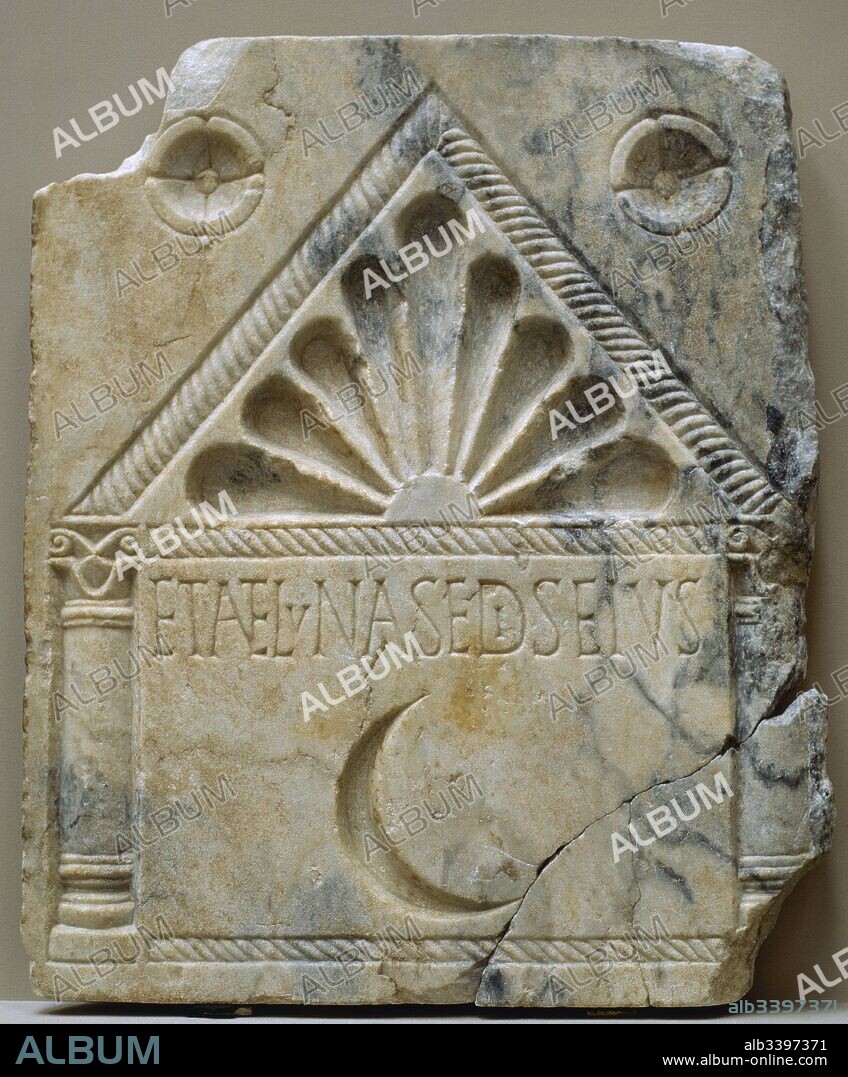alb3397371
Moon Plate. 4th century AD. Marble plaque (60 x 50 cm) that depicts an aediculae, partly engraved and partly in bas-relief, framing the figure of a crescent moon that has been sunk (in the fourth quarter), and the corresponding title in a moon. The aediculae is raised on a low pedestal edged by a cable at the top. At both ends of the cable are columns with an attic base, with a plinth, a smooth shaft and a composite capital. The temple is crowned by a high triangular pediment, bordered on three sides by a cable. Two small rosettes with sunken four petals are placed in the spandrels. From Merida (Spain). National Museum of Roman Art. Merida, Badajoz province, Extremadura, Spain.

|
Add to another lightbox |
|
Add to another lightbox |



Buy this image.
Select the use:

Caption:
Moon Plate. 4th century AD. Marble plaque (60 x 50 cm) that depicts an aediculae, partly engraved and partly in bas-relief, framing the figure of a crescent moon that has been sunk (in the fourth quarter), and the corresponding title in a moon. The aediculae is raised on a low pedestal edged by a cable at the top. At both ends of the cable are columns with an attic base, with a plinth, a smooth shaft and a composite capital. The temple is crowned by a high triangular pediment, bordered on three sides by a cable. Two small rosettes with sunken four petals are placed in the spandrels. From Merida (Spain). National Museum of Roman Art. Merida, Badajoz province, Extremadura, Spain.
Credit:
Album / Prisma
Releases:
Image size:
3976 x 4802 px | 54.6 MB
Print size:
33.7 x 40.7 cm | 13.3 x 16.0 in (300 dpi)
Keywords:
4TH CENTURY A. C. • 4TH CENTURY A. D • 4TH CENTURY A. D. • 4TH CENTURY AC • 4TH CENTURY AD • 4TH CENTURY • 4TH • 6TH CENTURY A. D. • 6TH CENTURY AD • 6TH CENTURY • AEDICULE • ALPHABET • ANCIENT AGE • ANCIENT WORLD • ANCIENT • ANTIGUEDAD • ANTIQUE • ANTIQUITIES • ANTIQUITY • ARCHAEOLOGY • ARCHEOLOGY • ART • ARTS • ASTROLOGIA • ASTROLOGY • ASTRONOMIA • ASTRONOMY • AUGUSTA EMERITA • BAS-RELIEF • DECOR • DECORATION • DECORATIONS • DECORATIVE • DEDICATION • DUSK • EMBOSSED • EMERITA AUGUSTA • EPIGRAPH • EPITAPH • ESTREMADURA • EUROPA • EUROPE • EVENING • EXTREMADURA • FOURTH CENTURY A. D. • FOURTH CENTURY • FUNERAL STELE • FUNERARY STELE • GABLE • GRAVESTONE • GRAVESTONES • GROWING • HEADSTONE • HEATHEN • HISPANIA • INNER DOOR • INSCRIPTION • KNICK-KNACKS • LEGEND • LUNA • LUNAR CRESCENT • LUNAR • LUSITANIA • MARBLE • MARBRE • MARMOL • MOON PLATE • MOON • MUSEUM OF ROMAN ART • NATIONAL MUSEUM OF ROMAN ART • OLD • ORNAMENT • ORNAMENTATION • ORNAMENTS • ORTHOSTAT • PAGAN • PAGANO • PEDIMENT • PLACA DE LA LUNA • REGISTRATION • RELIEF • RELIEFS • RELIEVE • ROMAN ART NATIONAL MUSEUM • ROMAN HISPANIA • ROMAN SCRIPT • SCULPTED • SCULPTING • SCULPTURE • SCULPTURE. • SCULPTURES • SCUPTURE • SPAIN • SPANISH • STELA • STELE • STELE, ALL • STELE, FUNERAL • SUNDOWN • SUNKEN RELIEF • SUNSET • TEMPLET • TOMBSTONE • TRIANGLE • TRIANGULAR • TWILIGHT • UNESCO WORLD HERITAGE SITE • VISIGODA • VISIGODO • VISIGODOS • VISIGOTH AGE • VISIGOTH • VISIGOTHIC • VISIGOTHS • WRITING


 Pinterest
Pinterest Twitter
Twitter Facebook
Facebook Copy link
Copy link Email
Email
